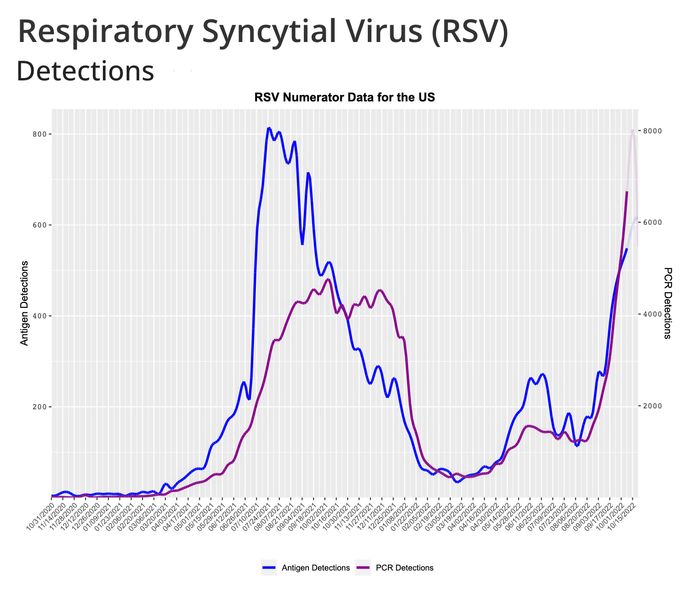A number of young children are being hospitalized because of respiratory syncytial virus, or RSV, and it’s happening at an unusual time of year and among older children than in years past. COVID-19 is likely to blame.
RSV infections and related emergency-room visits and hospitalizations are nearing seasonal peaks in some U.S. regions, according to the Centers for Disease Control and Prevention.
But the current RSV outbreak is different from previous outbreaks in several ways: It’s happening in the fall rather than the winter (RSV commonly peaks after the holidays, starting in late December); older children and not just infants are being hospitalized; and cases are occurring that are more severe than in previous years. And this year, RSV is circulating at the same time as COVID, influenza and other viruses like the biennial enterovirus, which was behind a rise in pediatric hospitalizations earlier this fall.
“The theory is that everyone’s now back together, and this is a rebound phenomenon,” said Jeffrey Kline, a physician and associate chair of research for emergency medicine at Wayne State University in Detroit.
Kline runs a national surveillance network that gathers data about viral infections from about 70 hospitals, including four pediatric hospitals. He says those data show that 318 children were hospitalized with acute respiratory illness brought on by RSV in the week starting Oct. 9, compared with 45 hospitalizations in the week starting July 25.
“If we think about the relative increase — ninefold increase — that’s not nothing, especially in the pediatric [emergency departments],” Kline said. “Holy mackerel.”

Source: CDC
The U.S. saw a massive spike in RSV cases in the summer of 2021, after masking and social distancing resulted a lull in infections the previous year. Even with that spike, fewer young children — 2-, 3-, and 4-year-olds — have been exposed to RSV than in a normal year. Most children have usually had at least one RSV infection by the time they are 2 years old, and as children get older, RSV becomes less worrisome, according to the CDC. Infants are at higher risk for severe disease brought on by RSV because babies have more immature immune responses than older children and because infants younger than 6 months of age breathe exclusively through their noses and cannot breathe through their mouths if they are congested.
“Age by itself is a risk factor for more severe disease, meaning that the younger babies are usually the ones that are sick-sick,” said Asuncion Mejias, a principal investigator with the Center for Vaccines and Immunity at the Research Institute at Nationwide Children’s Hospital in Columbus, Ohio. Now, she added, “we are seeing also older kids, probably because they were not exposed to RSV the previous season.”
But there’s another reason that COVID may be worsening some RSV infections in the youngest children. Mejias is studying whether a prior COVID infection or exposure somehow changes the way a baby’s immune system responds to RSV and whether it may lead to more severe illness from an RSV infection.
“That is something to work on and understand,” she said.
For now, however, worries are tied to the possibility of a “tripledemic” of COVID, influenza and RSV as the U.S. heads into what is expected to be a complicated season for respiratory infections. Stat News reported in mid-October that flu season is already underway, and the CDC said this week that this year’s flu activity may have “atypical timing and intensity.”
COVID itself remains a threat, as well. There are still more children being hospitalized with COVID than with RSV, Kline said, and some kids are getting sick from both viruses at the same time. About 5% of children are thought to test positive for both RSV and COVID, and 60% of the children in that group were hospitalized, according to Kline’s surveillance network.
“All these things are going on all at once right now,” said Alex Frost, managing director for StudyMaker, which is providing software infrastructure to the network. “But the shape of pediatric cases that are showing up in the emergency room is different than it used to be.”
